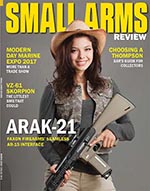Book Review: V22N3
By Dean Roxby
WEAPON OF CHOICE: SMALL ARMS AND THE CULTURE OF MILITARY INNOVATION
AUTHOR: MATTHEW FORD
PUBLISHER: OXFORD UNIVERSITY PRESS
ISBN: 9780190623869
COPYRIGHT: 2017
PAGES: 264, HARDCOVER, COLOR DUST JACKET, 5 ¾” x 8 ¾”
USD: $39.95
Ford Provides Well-Researched Look Into Rifle Purchases by Governments
This book is definitely not an easy read. Some books are rightly described as “page-turners,” the type that you just cannot put down. This is not one of those.
Having said that, it is a well-researched look at the complex and convoluted ways in which militaries and governments choose service rifles.
As firearms enthusiasts, we often discuss what rifle or cartridge should have been chosen or should be chosen next. We base this on little more than what is our favorite cartridge or gun maker. This book goes much deeper into the science behind such decisions, as well as the military and political backroom dealing as well.
Author Matthew Ford is a lecturer in International Relations at the University of Sussex, England. He earned a PhD in War Studies from King’s College London and is an Honorary Historical Consultant to the Royal Armouries. Additionally, he is a former West Point fellow and a founding editor of the British Journal for Military History. So, he is certainly well versed on military issues. Perhaps it should be no surprise that the book has 36 pages of endnotes and a bibliography spanning 12 pages.
The author begins by noting that the procurement of small arms was previously done in a logical, systematic way. Scientists would study the science of ballistics, particularly terminal ballistics, and come up with a set of parameters for bullet diameter, weight, velocity and so on. Then government engineers would build a suitable rifle around those parameters, based upon what the military felt they needed. With scientist, engineer and soldier all desiring much the same, the resulting service rifle should be a success.
Now, the government arms factories have been privatized, and big business is in the business of upselling their product. Ford goes into great detail about how complex this can be. He refers to “soldier status anxiety” and how soldiers are drawn to so-called “Gucci kit.” Arms makers are known to give flashy, expensive arms to various Special Forces teams in the hope that the regular Army will see these guns in use. Not wanting to be left behind with basic arms, they too will request these high-dollar status symbols. The book delves into this sociological aspect of selection. To quote from the Introduction, “This will show how the power of soldiers, engineers, scientists, bureaucrats, alliance partners, and industrialists has changed relative to each other since the Second World War.”
Ford notes that even a purely scientific approach is subject to some debate. Hunters still argue whether fast and light is better than slow and heavy.
Similarly, nations also view these decisions through their own situation. An example is given of the UK early in WW II. Being an island country under air raid attack, conserving limited raw materials was vital, so an overly large bullet and case might be “overkill.” Contrast that with the USA, with plenty of raw materials, not at war until two years after the UK and not subject to bombing raids on the mainland. For the US, a large, powerful round such as the .30-06 made perfect sense. Such logistical concerns are seldom considered by those outside the system, yet they do affect the process. Chapter 4, The Science of Killing, covers wound ballistics in detail.
Although the text is rather long-winded, Ford does keep focus by introducing the subject or concept for each chapter, (“I will examine …”), then exploring it in detail and closing with a summary (“I have demonstrated …”).
Had I not been assigned this title to review, I most likely would not have purchased or read it on my own. And that would have been my loss. This title offers a detailed behind-the-scenes look at the astoundingly complex path to weapons purchases. And as Ford asks, if it is this way for something as basic as a rifle, what occurs for enormously expensive and sophisticated items like fighter aircraft?
This article first appeared in Small Arms Review V22N3 (March 2018) |
| SUBSCRIBER COMMENT AREA |
Comments have not been generated for this article.




